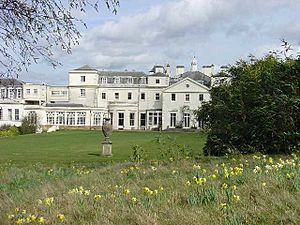John Campbell, 4th Duke of Argyll facts for kids
Quick facts for kids
The Duke of Argyll
|
|
|---|---|
 |
|
| Born | c. 1693 |
| Died | 9 November 1770 (aged 76–77) |
General John Campbell, 4th Duke of Argyll, was a Scottish soldier and politician. He was born around 1693 and passed away on November 9, 1770. He served in the British Parliament for a long time, from 1713 to 1761. He was also a high-ranking officer in the army.
Contents
Early Life of John Campbell
John Campbell was born in Scotland around the year 1693. His father was John Campbell of Mamore. His grandfather was Archibald Campbell, the 9th Earl of Argyll.
Family Life and Home
In 1720, John Campbell married Mary Drummond Bellenden. She was the daughter of John Drummond Bellenden, the 2nd Lord Bellenden of Broughton.
John and Mary had four children:
- Lady Caroline Campbell (born 1721, died 1803)
- Field Marshal John Campbell, 5th Duke of Argyll (born 1723, died 1806)
- Lord Frederick Campbell (born 1729, died 1816)
- Lord William Campbell (born 1731, died 1778)
Sadly, his wife Mary passed away in 1736.
John Campbell bought a place called Coombe Bank in Sundridge, Kent. He hired an architect named Roger Morris to build a country house there. After John's death in 1770, the house went to his second son, Frederick.
Military and Political Career
John Campbell joined the army in 1710. By the age of 19, he was already a Lieutenant Colonel. Soon after, he also entered the world of politics.
In 1713, he became a Member of Parliament (MP) for Buteshire. He continued to serve as an MP for different areas, including Elgin Burghs and Dunbartonshire. He was often elected without anyone running against him.
During his time as an MP, he also continued his military career. He became a Colonel of the 39th Regiment of Foot (1737–1738) and the 21st Regiment of Foot (1738–1752). He fought bravely in the Battle of Dettingen in 1743.
In 1746, John Campbell questioned Flora MacDonald. She was a famous Jacobite figure who helped Charles Edward Stuart escape to Skye. John Campbell wrote down Flora's statements.
He quickly rose through the army ranks:
- Brigadier General in 1743
- Major General in 1744
- Lieutenant General in 1747
In 1752, he became the Colonel of the North British Dragoons. He held this important position until he died.
Becoming the Duke of Argyll
In 1761, John Campbell's cousin, Archibald Campbell, the 3rd Duke of Argyll, passed away. John inherited the title and became the 4th Duke of Argyll. This meant he had to leave his seat in the House of Commons.
After becoming Duke, he took on new important roles:
- Governor of Limerick
- A Scottish representative peer (meaning he represented Scotland in the House of Lords)
- A Privy Councillor in 1762
- A full general in 1765
- A Knight of the Order of the Thistle in 1765, which is a very special honor.
Later Years and Death
The Duke of Argyll passed away on November 9, 1770. He was buried at Kilmun Parish Church. His eldest son, John, became the next Duke. His younger son, Lord William Campbell, was the last British Governor of South Carolina.


